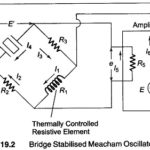Frequency Standards Articles:
Primary Standard: One arrangement is a carefully designed quartz crystal oscillator operating in the range 50 to 100 kHz, having a low temperature coefficient, constant amplitude output and voltage regulated power supply. The crystal oscillator has a long … (Read More)
Precision Frequency Standard: Most high precision frequency standard in use utilise a geometric transverse (GT) cut quartz crystal as the frequency controlling resonant elements having changes in frequency of less than 1 part in 10 million per day. This GT quartz … (Read More)

